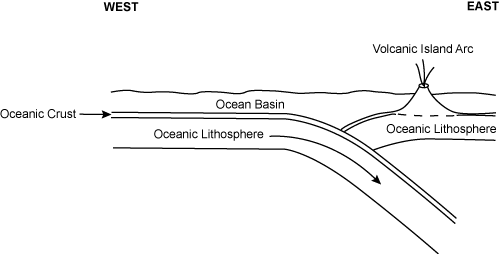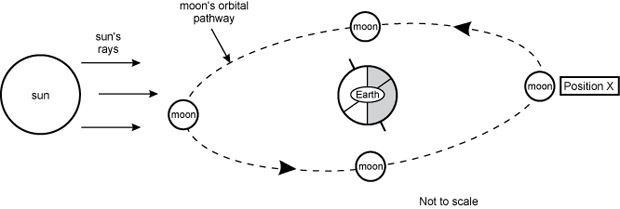Recommendation for individuals using a screenreader: please set your punctuation settings to "most."
Descriptive Statements:
- Demonstrate knowledge of Earth's formation, history, and structure, as well as the supporting geologic evidence.
- Analyze tectonic processes, the mechanisms driving plate movements, and the landforms and geologic phenomena produced by movement at plate boundaries.
- Demonstrate knowledge of the processes involved in the rock cycle and of the characteristics of igneous, metamorphic, and sedimentary rocks.
- Analyze the constructive and destructive processes that shape Earth's surface, including weathering, erosion, transportation, and deposition.
- Recognize the characteristics and origins of common rocks, minerals, and fossils, as well as mineral, geothermal, and fossil fuel resources.
- Demonstrate knowledge of the effects of continental glaciations during the Pleistocene epoch and the characteristics of glacial deposits.
Sample Item:

The left end of the diagram is labeled West and the right end is labeled East. At each end of the diagram is a tectonic plate consisting of a thin layer, labeled Oceanic Crust, and a thick layer beneath it, labeled Oceanic Lithosphere. Above them is a water line and a label identifying the Ocean Basin. The western plate is shown moving from west to east. Where it meets the eastern plate, it curves downward to slide under the eastern plate. Slightly to the east of the subduction point, a volcanic cone rises from the eastern plate to above the water line, with the label Volcanic Island Arc.
The diagram above shows one oceanic tectonic plate being subducted beneath another. Over time, a volcanic island arc forms east of the subduction zone. Which of the following is the underlying process primarily responsible for the formation of the volcanic island arc?
- Water released from the subducting plate lowers the melting temperature of some of the mantle, forming plumes of magma that rise toward the surface.
- Plumes of molten material from the core-mantle boundary are forced upward by convection currents produced by the descending plate.
- Intense pressure generates heat that melts the subducting plate and the sediments it carries, producing molten material that flows upward into magma chambers.
- Frictional heating completely melts the descending plate by the time it reaches the lower mantle producing buoyant magma plumes.
Correct Response and Explanation (Show Correct ResponseHide Correct Response)
A. This question requires the examinee to analyze tectonic processes, the mechanisms driving plate movements, and the landforms and geologic phenomena produced by movement at plate boundaries. A major factor controlling the temperature at which rock melts is the water content in the rock. As an oceanic plate descends into the mantle beneath another tectonic plate, water and other volatiles in the ocean crust are driven off by the increasing heat and pressure. The water moves upward into the overlying mantle rock, lowering the melting temperature enough to produce some magma. This magma then rises toward the surface, ultimately forming a string of islands that parallel the subduction zone known as an island arc.
Descriptive Statements:
- Analyze the physical processes driving the hydrologic cycle (e.g., solar heating, evaporation, condensation).
- Identify the processes and characteristics of marine and freshwater systems, including oceans, rivers, lakes, glaciers, and groundwater systems.
- Analyze coastal processes, the formation of barrier islands, and the characteristics of deltas and estuaries.
- Demonstrate knowledge of the structure and characteristics of the different layers of the atmosphere and the atmospheric and geographic factors that produce different types of weather, including hazardous weather events.
- Analyze weather conditions, maps, and data to predict and explain weather events.
- Demonstrate knowledge of the geographic factors that control regional climate conditions.
- Analyze the causes and effects of current and past changes in global climates on ecosystems, the hydrosphere, coastal processes, and agriculture.
- Recognize the significance of interactions of the ocean and the atmosphere.
Sample Item:
At a certain height in the atmosphere, a rising parcel of air reaches its dew point and becomes saturated, leading to cloud formation. Which of the following best describes what occurs at the molecular level during this process?
- The rising parcel of air carries dust and other condensation nuclei into the upper troposphere, where the high concentration of water vapor supports cloud formation.
- The rising parcel of air mixes with its surroundings, increasing turbulence and the speed at which individual water molecules collide, causing them to merge into water droplets that attract condensation nuclei.
- The rising parcel of air cools and contracts in the upper troposphere, forcing water molecules into closer and closer contact until they collide and form clouds.
- The rising parcel of air cools, slowing the motion of water molecules and increasing the likelihood that individual water molecules that collide will stick together on condensation nuclei and form water droplets.
Correct Response and Explanation (Show Correct ResponseHide Correct Response)
D. This question requires the examinee to analyze the physical processes driving the hydrologic cycle (e.g., solar heating, evaporation, condensation). Rising air expands because atmospheric pressure decreases with height. The kinetic theory of gases states that gases are composed of many small particles in a state of constant random motion and that these particles are constantly colliding with each other. With increasing space between the particles in the expanding parcel of air, the average velocity of the particles drops. Since the average velocity of particles in a gas is a measure of the temperature of the air parcel, a drop in average particle velocity means a drop in temperature. Molecules of gaseous water in the air also move more slowly in cooler air and as these water molecules in the gas phase collide, some stick together. The cooler the air mass, the greater the number of water molecules that stick together after a collision. Condensation nuclei in the atmosphere support this process because water vapor molecules in a cooling air mass generally need a surface on which to condense. When a rising air parcel reaches the dew point as it becomes saturated, water vapor condenses on these particles to produce large water droplets that are visible as clouds.
Descriptive Statements:
- Demonstrate knowledge of the formation of the solar system and the characteristics of planets, asteroids, comets, and planetary satellites.
- Demonstrate knowledge of the apparent motion of objects in the sky and the celestial sphere model.
- Analyze the interactions of the sun, the moon, and Earth and the effects of these interactions on Earth systems.
- Recognize the characteristics and evolution of stars and galaxies, including theories on the origin and nature of the universe.
- Demonstrate knowledge of evidence supporting the current understanding of the solar system and universe and of the technology and methods used to gather that evidence.
- Demonstrate knowledge of the role of gravity in the solar system and the universe.
Sample Item:

To the left is the sun, with arrows labeled sun's rays pointing toward Earth. The side of Earth away from the sun is shaded. Earth's axis is shown tilted to the left, and the equator is drawn perpendicular to the axis. The moon's orbit, labeled moon's orbital pathway, is shown tilted slightly, with the left end lower than the center of Earth and the right end higher. The moon is shown at four points on the orbital path: at the point closest to the sun, the point farthest from the sun, and the two points halfway between. The point farthest from the sun is labeled Position X. A label indicates that the diagram is not to scale.
At approximately which time of day will the moon rise when it is at position X in the diagram above?
- sunrise
- noon
- sunset
- midnight
Correct Response and Explanation (Show Correct ResponseHide Correct Response)
C. This question requires the examinee to analyze the interactions of the sun, the moon, and Earth and the effects of these interactions on Earth systems. During the lunar cycle, position X in the diagram is the position that the moon occupies when it is full. The moon during this phase is on the side of Earth facing away from the sun (i.e., the night-time side of Earth), therefore it is only visible between sunset and sunrise. Conversely, when the moon is between the sun and Earth, it is a new moon that is faintly visible rising at sunrise and setting at sunset.

